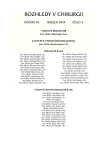GIST of the small bowel in neurofibromatosis terrain as a source of massive bleeding
Authors:
R. Slováček 1; Z. Adamová 1; P. Mičulka 2
Authors‘ workplace:
Chirurgické oddělení Vsetínské nemocnice, a. s., přednosta: MUDr. J. Sankot
1; Oddělení patologické anatomie Vsetínské nemocnice a. s., přednosta: MUDr. P. Mičulka
2
Published in:
Rozhl. Chir., 2014, roč. 93, č. 3, s. 143-146.
Category:
Case Report
Overview
Neurofibromatosis type I (Morbus Von Recklinghausen) is an autosomal dominant disorder. The major diagnostic criteria include multiple cutaneous neurofibromas, café au lait spots, that are rarely found in the gastrointestinal tract. 5–25% of these lesions, however, may develop into gastrointestinal stromal tumours. We report the case of a 69-year-old woman with Von Recklinghausen disease. She was admitted due to gastrointestinal bleeding. During surgery we found, among multiple neurofibromatic intestinal lesions, macroscopically different bleeding tumours. They were completely removed. Histological examination revealed gastrointestinal stromal tumour.
Using an immunohistological assay, we examined stored specimens from previous operations on the same patient: one anal polyp removed a year ago and tumours removed 32 years ago and regarded as polyps then were re-classified as gastrointestinal stromal tumours.
In the discussion, the authors address the issue of which examination of the intestine would be appropriate to find out the source of bleeding in the small intestine and how to distinguish intestinal stromal tumours in the terrrain of intestinal neurofibromatosis. Another issue addressed is a screening examination in patients with skin forms of Recklinghausen’s disease.
To successfully manage intestinal bleeding, close cooperation among the surgeon, the endoscopist and the radiologist is indispensable. In order to quickly establish the right diagnosis and subsequently target treatment promptly, it is very helpful to know the patient’s exact personal medical history and also the possible complications of chronic diseases.
Key words:
neurofibromatosis – stromal – tumour – bleeding – intestinal tract
Sources
1. Behranwala KA, Spalding D, Wotherspoon A, et al. Small bowel gastrointestinal stromal tumours and ampularry cancer in Type I neurofibromatosis. World Journal of Surgical Onkology 2004;2:1.
2. Páral J, Lochman P, Kalábová H, Hadži-Nikolov D. GIST: Novodobé poznatky a léčebné modality. Rozhledy v chirurgii 2012;91:189–198.
3. Tsukuda K, Ikeda E, Takagi S, et al.Multiple Gastrointestinal Stromal Tumors in Neurofibromatosis Type 1 Treated with Laparoscopic Surgery. Acta Med Okayama 2007;61:47–504.
4. Ferda J. CT angiografie. Praha, Galén 2004:272–273.
5. Van den Abeele AD. The lessons of GIST-PET and PET/CT: a new paradigm for imaging. Onkologist 2008;13(Suppl):8–13.
6. Takakuraa K, Kajiharaa M, Sasakia S, et al.Use of Balloon Enteroscopy in Preoperative Diagnosis of Neurofibromatosis-Associated Gastrointestinal Stromal Tumours of the Small Bowel. Case Rep Gastroenterol 2011;5:308–314.
7. Matek J, Krška Z. GIST jako invaginace na tenkém střevě. Rozhledy v chirurgii 2009;88:425– 427.
Labels
Surgery Orthopaedics Trauma surgeryArticle was published in
Perspectives in Surgery

2014 Issue 3
Most read in this issue
- Lymphatic metastasizing – viewed by pathologist
- Pathologic fluid collection of mesentery, differential diagnosis of mesenteric cysts – case report
- Transtibial amputation: sagittal flaps in patients with diabetic foot syndrome
- Injury of the extensor mechanism in the zone I – mallet deformity
